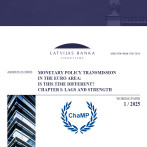Seasonal contraction in money supply insignificant in January
January usually registers a drop in money supply, which follows December with its rapid rise in expenditures, high consumer activity and a substantial demand for cash currency. Yet this January, against the background of economic recovery, the contraction in the money supply was much more moderate than a year ago, and the rise in some money indicators, moreover, continued even during the traditionally quiet first month of the year. As deposits in lats contracted moderately and deposits in foreign currencies continued to grow, the total balance of deposits attracted by banks shrank only slightly; the contraction in cash currency demand was likewise slight. At the same time, the banks' total credit portfolio continued to shrink albeit at a slower rate than in December.
Money indicator M3, which characterizes the amount of cash and non-cash currency in the economy, dropped 0.8% in January while the annual growth rate of M3 increased to 11.8% due to the base effect. The M3 contraction resulted from the 2.1% decrease in cash currency and the 2.2% drop in household lats deposits. As a result of growing economic activity, however, the level of enterprise deposits remained practically unchanged in January. The accrual-forming trends did not change materially, as the drop in term deposits in January was partly counterbalanced by a rise in deposits with a term for an advance warning of withdrawal. One should note, however, the 2.7% drop in household overnight deposits: it is the fastest in the last twelve months and could indicate the wish of the population to maintain a certain level of consumption in the conditions of the growing tax burden and inflation.
The domestic loan balance dropped 0.6% in January while the annual rate of loan contraction remained unchanged at 8.3%. The decrease resulted primarily from the gradual drop in the balance of housing loans granted to households, whereas lending to non-financial enterprises dropped by a mere 0.2% and the balance of loans granted to enterprises in lats increased for a third consecutive month (10.0% in January), thus raising the proportion of lats loans slightly (by 0.7 percentage points) in the portfolio of loans granted to businesses.
In the spring months a gradual increase of funds at the disposal of businesses could have a positive effect; this is evidenced by the overall stabilization of the economy; bank promises of prudently raising the rate at which lending to the enterprise sector is taking place in case of quality projects; as well as the resumed activity in the lats lending market. The situation is different in the household sector where the amount of deposits is likely to drop as households face increased expenditures to meet the double challenge of rising energy and food prices and raised taxes.
Textual error
«… …»






